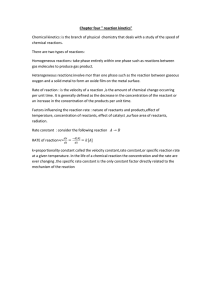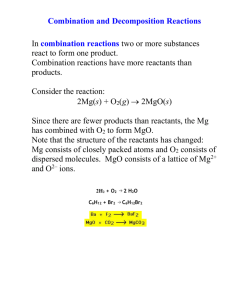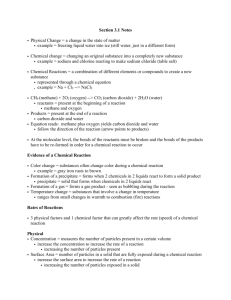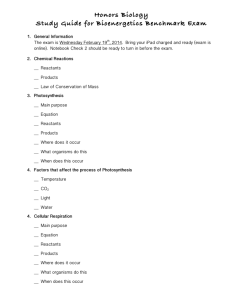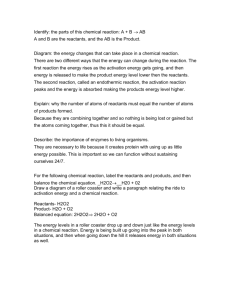Localization transition of a dynamic reaction front M J E Richardson
advertisement
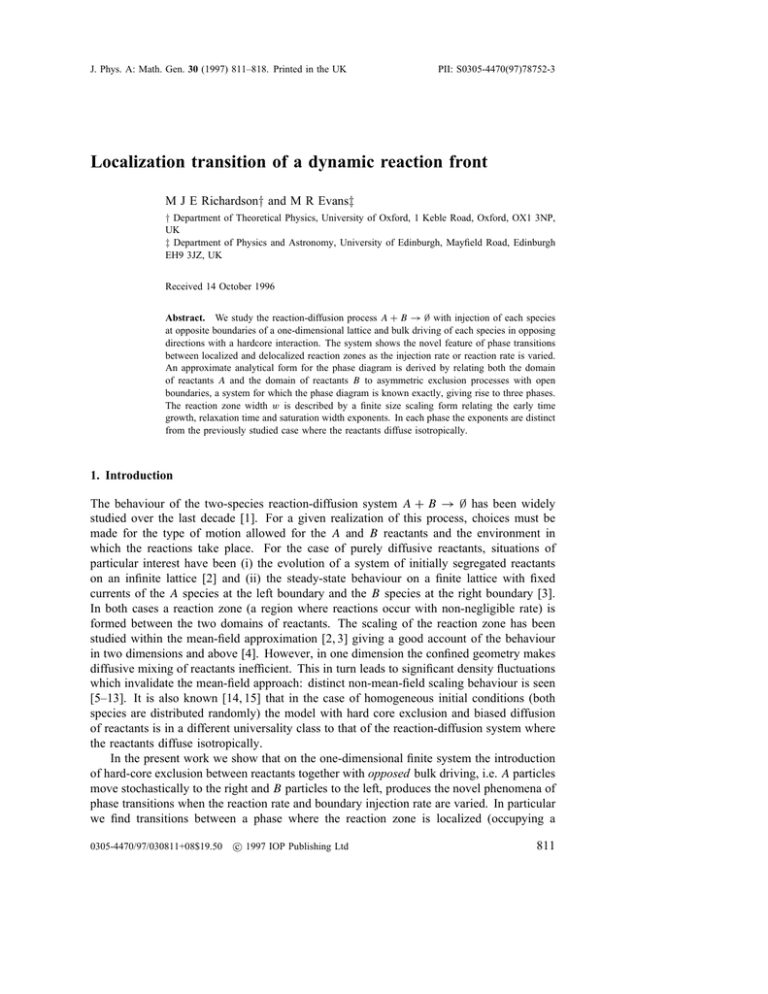
J. Phys. A: Math. Gen. 30 (1997) 811–818. Printed in the UK
PII: S0305-4470(97)78752-3
Localization transition of a dynamic reaction front
M J E Richardson† and M R Evans‡
† Department of Theoretical Physics, University of Oxford, 1 Keble Road, Oxford, OX1 3NP,
UK
‡ Department of Physics and Astronomy, University of Edinburgh, Mayfield Road, Edinburgh
EH9 3JZ, UK
Received 14 October 1996
Abstract. We study the reaction-diffusion process A + B → ∅ with injection of each species
at opposite boundaries of a one-dimensional lattice and bulk driving of each species in opposing
directions with a hardcore interaction. The system shows the novel feature of phase transitions
between localized and delocalized reaction zones as the injection rate or reaction rate is varied.
An approximate analytical form for the phase diagram is derived by relating both the domain
of reactants A and the domain of reactants B to asymmetric exclusion processes with open
boundaries, a system for which the phase diagram is known exactly, giving rise to three phases.
The reaction zone width w is described by a finite size scaling form relating the early time
growth, relaxation time and saturation width exponents. In each phase the exponents are distinct
from the previously studied case where the reactants diffuse isotropically.
1. Introduction
The behaviour of the two-species reaction-diffusion system A + B → ∅ has been widely
studied over the last decade [1]. For a given realization of this process, choices must be
made for the type of motion allowed for the A and B reactants and the environment in
which the reactions take place. For the case of purely diffusive reactants, situations of
particular interest have been (i) the evolution of a system of initially segregated reactants
on an infinite lattice [2] and (ii) the steady-state behaviour on a finite lattice with fixed
currents of the A species at the left boundary and the B species at the right boundary [3].
In both cases a reaction zone (a region where reactions occur with non-negligible rate) is
formed between the two domains of reactants. The scaling of the reaction zone has been
studied within the mean-field approximation [2, 3] giving a good account of the behaviour
in two dimensions and above [4]. However, in one dimension the confined geometry makes
diffusive mixing of reactants inefficient. This in turn leads to significant density fluctuations
which invalidate the mean-field approach: distinct non-mean-field scaling behaviour is seen
[5–13]. It is also known [14, 15] that in the case of homogeneous initial conditions (both
species are distributed randomly) the model with hard core exclusion and biased diffusion
of reactants is in a different universality class to that of the reaction-diffusion system where
the reactants diffuse isotropically.
In the present work we show that on the one-dimensional finite system the introduction
of hard-core exclusion between reactants together with opposed bulk driving, i.e. A particles
move stochastically to the right and B particles to the left, produces the novel phenomena of
phase transitions when the reaction rate and boundary injection rate are varied. In particular
we find transitions between a phase where the reaction zone is localized (occupying a
c 1997 IOP Publishing Ltd
0305-4470/97/030811+08$19.50 811
812
M J E Richardson and M R Evans
vanishingly small fraction of the system in the thermodynamic limit) to phases where it is
delocalized (filling the whole system).
Let us first discuss the situation where no bulk drive is imposed: the reactants are
not driven but just diffuse. On the infinite system with initially segregated reactants, the
reaction zone width w is expected to grow (in the scaling regime) as t α . Mean-field theory
predicts α = 16 [2] whereas one-dimensional simulations and scaling arguments point to
α = 14 [5, 6, 8, 7, 12, 11]. In fact a RG calculation [13] suggests logarithmic corrections
w ∼ t 1/4 (log t)1/2 which may explain the slow convergence to α = 14 found in several
simulations [9, 8, 12].
In the complementary situation of a finite lattice of size L where reactant A is injected
at the left boundary (site 1) and reactant B is injected at the right (site L), the system
attains a steady state as t → ∞. The scaling of the reaction zone is predicted in meanfield theory to depend on the injected flux j , reaction rate λ and diffusion constant of
reactants D through w ∼ (D 2 /(j λ))1/3 [3]. This is distinct from the one-dimensional
case where scaling arguments [8, 11] and a RG calculation [10] suggest w ∼ (D/j )1/2 .
Recently it has been shown that when the wandering as well as the intrinsic contribution
to the reaction zone width is taken into account, RG and Monte Carlo simulations predict
w ∼ (D/j )1/2 (log L)1/2 [13].
We now consider the effects of hardcore exclusion (though still with no drift) with
reactions occurring between particles on neighbouring sites. On the infinite system the
exclusion is not expected to affect the value of α. However, one effect of exclusion on the
finite lattice is that that current can no longer be fully controlled from outside the system,
since a reactant can only enter if a boundary site is empty. If one attempts to inject reactants
at a finite rate the resultant current is in fact O(1/L). To see this note that in the bulk the
where ρ is the concentration. Now, due to exclusion the maximum value ρ
current is D dρ
dx
can take is one, therefore, if we assume a reaction zone w L the concentration gradient,
and hence the current, is of order 1/L. From this we deduce w ∼ 1/j 1/2 ∼ L1/2 confirming
that the reaction zone is localized i.e. w/L → 0 as L → ∞.
In order to relate the behaviour on the the finite system to the infinite system with
initially segregated reactants a finite size scaling form appears natural. The early time
growth of the reaction zone on the finite system should be the same as that on the infinite
system since the effect of the boundaries will not have been felt: the boundaries will only
influence the dynamics after a time t ∼ Lz . Therefore, ignoring any logarithmic corrections,
we propose a finite size scaling form
w ∼ t α f (t/Lz ).
(1)
From the t → ∞ limit discussed in the previous paragraph we have the scaling relation
1
= αz. When α takes its expected value of 14 this implies z = 2, consistent with a diffusive
2
motion of reactants. We ran simulations (with hardcore exclusion) and found agreement
with the scaling form but with α ' 0.29. This is consistent with other simulations where a
slow approach to α = 0.25 has been found.
In the following we consider the effects of opposed bulk driving together with exclusion
and with boundary injection on the reaction zone behaviour. We shall show (i) that phase
transitions occur as the reaction rate and injection rate are varied, and (ii) in all phases
finite size scaling forms (1) hold but have different α, z to the isotropic diffusion case. In
particular two phases are predicted where the reaction zone width varies as w ∼ O(L) and
is thus delocalized.
Localization transition of a dynamic reaction front
813
2. Definition of the model
The model consists of a one-dimensional lattice of L sites, each of which can be occupied
by a single particle, either of type A or B, or unoccupied (which we denote by 0). Type A
particles are injected at the left edge of the system and type B particles are injected at the
right, both with rate δ. Once in the lattice, the As always hop to the right and the Bs always
hop to the left. If an A particle and a B particle are ever on adjacent sites they react with
rate λ and are both removed from the lattice. Since particles cannot occupy the same site,
we see that once an A B pair are adjacent they simply wait a random time, exponentially
distributed with mean λ−1 , before annihilating. An inert product of the reaction is then
deposited on the sites previously occupied by the particles. However, this product plays no
further role in the evolution of the system.
The dynamics can be written in terms of microscopic rules for a bond of two adjacent
sites i, i + 1 in the bulk of the system
Ai 0i+1 → 0i Ai+1
Ai Bi+1 → 0i 0i+1
and
0i Bi+1 → Bi 0i+1
with rate λ
both with rate
(2)
where these rules are valid for 1 6 i 6 (L − 1). At the boundaries we have injection of
particles
01 → A1
and
0L → BL
both with rate δ, at the LHS and RHS respectively.
(3)
(If either an A or a B particle ever reaches the opposite end of the lattice it is removed with
unit rate. This, seldom, occurs and has a negligible effect on the behaviour of the system.)
The rules thus specified allow one to simulate the model numerically by Monte Carlo
techniques. We define ai and bi as the binary variables denoting occupation of site i by an
A or B particle respectively (i.e. if site i has an A particle on it ai = 1 otherwise ai = 0).
We also define hX(t)i as the quantity X at time t starting from some fixed initial condition
and averaged over the stochastic dynamics up to time t. In a Monte Carlo simulation this
is conveniently performed by averaging over many systems, each one having been evolved
from the same initial state at t = 0. Quantities of interest can now be considered such as
the particle densities hai i, hbi i.
As the dynamics does not allow for particles to pass through each other, the system is
segregated into two domains: a domain comprising As and 0s and a domain comprising Bs
and 0s. The reaction front is defined as being at the instantaneous position of the interface
of the two domains (strictly only defined when an A and B particle are on adjacent sites).
Due to the fluctuating particle currents flowing into the interface, the reaction front will
move stochastically through the lattice. The probability of finding the reaction front at bond
i, i + 1 at time t is hai (t)bi+1 (t)i giving the rate of production of the inert product at site
i, Ri (t), as λ(hai−1 (t)bi (t)i + hai (t)bi+1 (t)i). The distribution R(t) will be used to define
the reaction zone, the region where reactions can occur with non-zero rate, which in turn
characterizes the phase structure of the model.
3. The phase diagram
The parameter space of the model is spanned by δ (the injection rate) and λ (the reaction
rate). Using Monte Carlo simulation with initial conditions of segregated reactants, we
examined the density profiles hai i, hbi i over a time-scale less than the typical time for large
fluctuations of the reaction front to occur (short time average) and in the t → ∞ limit
814
M J E Richardson and M R Evans
Figure 1. Short and long time averages for each phase from Monte Carlo simulation. The
full squares plot the density of A; the empty squares plot the density of B; the line plots the
distribution of inert product, normalized so that maximum value is 12 . Long time averages were
carried out over 108 MCS. The short time averages were over 300 MCS for phase I and 500
MCS for phases II and III all averaged over 5000 systems. The values of (δ, λ) are Phase I (0.2,
9); Phase II (0.7, 0.3); Phase III (0.9, 10).
(long time average). The normalized distribution of the inert product (proportional to the
production rate) was also measured. Considering 0 6 δ 6 1 and 0 6 λ < ∞ we determined
three distinct phases, existing in the following approximate regions (see figure 1).
Phase I. 0 < δ < 0.5 and δ << λ. The short-time average shows flat profiles of particle
density ' δ away from the reaction zone. The long-time average shows linearly decaying
profiles with a broad distribution of inert product. This implies the reaction front is likely
to visit all sites of the system: the reaction front is delocalized and the reaction zone fills
the system. (The structures near the boundaries are of finite lateral extent and are therefore
unimportant in the large L limit.)
Phase II. 0 < λ < 1 and λ << δ. Again, the short-time average shows flat particle
profiles away from the reaction zone, though in this phase the density is a function of λ.
As in phase I, the long-time average shows clear evidence for a delocalized reaction front
and a reaction zone that fills the system.
Phase III. δ > 0.5 and λ > 1. The short and long time averages show power law
decays of the density profiles away from the boundaries and reaction front (i.e. long range
structure). The long-time average shows a peaked distribution of inert product near the
centre of the system. The reaction front is localized and the width of the reaction zone is
much less than the system size.
An approximate analytical form for the phase diagram can be easily derived from
a knowledge of the totally asymmetric simple exclusion process (TASEP). The TASEP
comprises a system of particles moving stochastically in a preferred direction with hardcore
exclusion interactions on a lattice of N sites. In the case of open boundary conditions
[16–18] the microscopic rules are: Ai 0i+1 → 0i Ai+1 with rate 1 across all sites i, i + 1
where i = 1 → (N − 1) and at the boundaries there is injection of particles 01 → A1 with
rate δ at the LHS and ejection of particles AN → 0N with rate β at the RHS. The TASEP
Localization transition of a dynamic reaction front
815
has three phases: a low density phase (density ρ = δ) for δ < 0.5 and β > δ, a high density
phase (ρ = 1 − β) for β < 0.5 and δ > β and a maximal current phase (ρ = 0.5) for
δ > 0.5 and β > 0.5.
A simple approximation to the reaction diffusion model can be made by considering
each domain of reactants as a TASEP (hopping to the right for the A particles and to the
left for the B particles). The underlying assumption is a separation of time-scales i.e. that
the domains equilibrate to TASEP profiles faster than the time taken for large fluctuations
in the position of the reaction front to occur. Therefore, an effective ejection rate for the A
particles can be defined as βeff ' λρB where ρB is the density of B particles at the reaction
front. As we are assuming the reaction front is stationary on the time-scale of the TASEP
ρB ' ρA . In the TASEP β can be thought of as the density of a reservoir of holes just
outside the RHS of the lattice, implying βeff ' (1 − ρA ). Hence, a self-consistent relation
can be written for βeff in terms of λ:
λ(1 − βeff ) = βeff .
(4)
With this relation the phases of the TASEP can be re-interpreted in terms of the reactiondiffusion system. Defining ρ as the (short-time average) density of reactants far away
from the reaction front, we find the following phase boundaries and densities within this
approximation:
λ
ρ = δ.
Phase I. in the region 0 < δ < 0.5 and δ < 1+λ
λ
Phase II. in the region 0 < λ < 1 and 1+λ < δ
ρ = (1 + λ)−1 .
Phase III. in the region δ > 0.5 and λ > 1
ρ = 12 .
In phase I, the TASEP approximation for the density of reactants is in excellent
agreement with simulation. However, in phase II ρ is slightly less than (1+λ)−1 , the TASEP
prediction. It also appears from simulations, that the phase II/phase III phase boundary may
be displaced from its predicted position (although the usual difficulties of locating a secondorder phase transition make it hard to be sure). These observations suggest that the above
approximation for βeff might be improved: the approximation clearly neglects fluctuations
in the position of the reaction front as well as correlations in time for the occurrence of
reactions.
4. Localization measurements
A quantity of physical
R t relevance—the total amount of inert product deposited onto a site up
to time t, Ri (t) = 0 Ri (t 0 ) dt 0 , can be used to study the extent to which the reaction front
is localized in each of the phases. Therefore, the time-dependent width of the distribution
of deposited inert product, which we take to define the reaction zone, is given by:
w 2 (t) =
L
L
X
X
(k − kf )2 Rk (t)/
Rk (t)
k=1
k=1
where kf =
L
X
k=1
kRk (t)/
L
X
Rk (t).
(5)
k=1
4.1. Steady state width
For the reaction front to be considered localized, the steady state width, w∞ = limt→∞ w(t),
must scale as Lγ with γ < 1. By Monte Carlo simulation, the exponent γ was measured
for various L for the three phases, see figure 1. The exponents measured were: phase I
γ ' 1.01 ± 0.02, phase II γ ' 1.04 ± 0.05 and phase III γ ' 0.75 ± 0.01, suggestive
of γ = 1, 1, 34 respectively. In phase I and II the distribution of the inert product remains
constant in the limit L → ∞. However, in phase III the fraction of the system containing
816
M J E Richardson and M R Evans
Figure 2. (a) Log–log plot of the relaxation time τ (see main text) versus system size L. The
measured gradients predict τ ∼ Lz where z = 1.93 ± 0.08 in phase I; z = 2.02 ± 0.05 in
phase II; z = 2.25 ± 0.02 in phase III. (b) Log–log plot of the reaction zone width w defined
in (5) versus L. The measured gradients predict w ∼ Lγ where γ = 1.01 ± 0.02 in phase I;
γ = 1.04 ± 0.05 in phase II; γ = 0.75 ± 0.01 in phase III In both (a) and (b) the values of
(δ, λ) are phase I (0.2, ∞); phase II (1, 0.2); phase III (1, ∞).
the inert product vanishes as ∼ L−1/4 i.e. the reaction front is localized in the middle of the
system.
4.2. Relaxation time
In order to investigate the dynamical properties of the model we considered the time taken
for the system to relax to steady state behaviour (expected to vary as τ ∼ Lz ). We measured
the exponent z by evolving the system from an initial configuration with the reaction front
at a boundary, i.e. the system full of A particles, and examining the L dependence of τ
the time taken for the reaction front to reach the centre of the system, see figure 2. Monte
Carlo simulations averaged over ∼ 500 systems gave: phase I z ' 1.93 ± 0.08, phase II
z ' 2.02±0.05 and phase III z ' 2.25±0.02, suggestive of 2, 2, 94 respectively. In phases I
and II simulations suggest that the reaction front behaves as an unbiased random walker:
after waiting a time ∼ L2 the reaction front will have explored the whole system. In the
TASEP approximation this is expected from the flat profiles and the lack of long-range
correlations in these phases. Indeed, in the limit λ → 0 (in phase II) the system will be
devoid of zeros except when occasional reactions happen and it is easy to show that the
dynamics of the front is exactly that of a random walk. In phase III the time taken for the
the front to reach the centre of the system varies as ∼ L9/4 , i.e. the motion is subdiffusive.
However, when the time taken for the front to travel from the centre of the system to a
boundary was measured it was found to increase exponentially with L. This implies that in
phase III the reaction front is stable over short periods of time, but the net motion is biased
towards the centre of the system.
4.3. Finite size scaling forms
A commonly studied situation in reaction-diffusion systems is the evolution of the system
from an initial configuration (at t = 0) of segregated reactants. In this case, initially half the
lattice (i = 1 → L/2) contains A particles with density 12 and the other half of the lattice
(i = L/2 → L) contains B particles, also of density 12 . We expect the growth of w(t) from
the initial condition w(0) = 0 to follow a finite size scaling form (1). As w(∞) = Lγ we
have the scaling relation γ = zα giving, in conjunction with our above results, α = 12 for
phases I and II and for the localized phase III α = 13 . The function w(t) was measured
Localization transition of a dynamic reaction front
817
Figure 3. Finite size scaling collapses for various values of L between 200 and 1000. w/Lγ
versus t/Lz with (a) γ = 34 , z = 94 (see equation 7) for phase III (b) γ = 1, z = 2 (see
equation 6) for phase I (empty symbols) and phase II (full symbols).
for various L for phases I, II and III. The data collapse (figure 3) supports the following
scaling forms where gI,I I , g̃I,I I , h, h̃ are scaling functions:
t
t
or
w(t)
=
L
g̃
.
(6)
For phases I and II w(t) = t 1/2 gI,I I
I,I
I
2
L
L2
t
t
3/4
h̃
or
w(t)
=
L
.
(7)
For phase III w(t) = t 1/3 h
L9/4
L9/4
For phases II and III we believe the data collapses are convincing evidence of the scaling
form. However, for phase I larger simulations are really required to confirm the early time
growth region (w ∼ t 1/2 ).
5. Discussion
We have introduced a variant of the A + B → ∅ reaction-diffusion system which shows
transitions between phases with delocalized and localized reaction zones as the injection rate
δ and reaction rate λ are varied. By treating a single domain of a reactant as a TASEP, an
approximate relationship (4) for an effective ‘ejection rate’, βeff , can be found in terms of λ,
allowing an approximate phase diagram to be derived. A particularly interesting transition
is that from phase I (delocalized reaction zone) to phase III (localized reaction zone), which
occurs (for δ < 12 ) by simply increasing the reaction rate.
In each of the phases the exponents {α, z, γ } (early time growth of the reaction zone
w ∼ t α ; relaxation time t ∼ Lz ; reaction zone saturation width w ∼ Lγ ) obey the finite size
scaling relation αz = γ . In each case, { 12 , 2, 1} for the delocalized phases and { 13 , 94 , 34 } for
the localized phase, these exponents are distinct from those of the model discussed in the
introduction where the reactants have no bias ({ 14 , 2, 12 }) suggesting a different universality
class for the present model. We believe that the new exponents are related to the behaviour
of current fluctuations in the TASEP [18] which in turn are related to KPZ exponents,
although we could not find a clean argument.
It would be interesting to examine the robustness of the model to (i) relaxation of the bias
to allow for a small backward hopping rate of reactants, and (ii) relaxation of the hardcore
exclusion between the different species. If the TASEP approximation is valid the effect of
relaxing the bias should preserve the phase structure of the model: partially asymmetric
exclusion and asymmetric exclusion belong to the same universality class. However, the
relaxation of hardcore exclusion between A and B reactants may strongly affect phase II
where the reaction rate is low.
818
M J E Richardson and M R Evans
Finally, it would be illuminating to make precise the relation of our TASEP
approximation of the reaction diffusion system to a conventional mean field theory which
would be expected to hold in dimension d > 2. One could then explore the feasibility of the
RG approach which has been successful in the case where the reactants diffuse isotropically
[13].
Acknowledgments
We thank J Cardy, S Cornell, M Howard, Z Rácz and S Redner for useful discussions
and correspondence. MJER acknowledges financial support from EPSRC under award
no 94304282. MRE is a Royal Society University Research Fellow.
References
[1] For a recent review of diffusion controlled annihilation see Redner S 1996 Nonequilibrium Statistical
Mechanics in One Dimension ed V Privman (Cambridge: Cambridge University Press)
[2] Gálfi L and Rácz Z 1988 Phys. Rev. A 38 3151
[3] Ben-Naim E and Redner S 1992 J. Phys. A: Math. Gen. 25 L575
[4] Koo Y-E L and Kopelman R 1991 J. Stat. Phys. 65 893
[5] Cornell S, Droz M and Chopard B 1991 Phys. Rev. A 44 4826
[6] Araujo M, Havlin S, Larralde H and Stanley H E 1992 Phys. Rev. Lett. 68 1791
[7] Larralde H, Araujo M, Havlin S and Stanley H E 1992 Phys. Rev. A 46 6121
[8] Cornell S and Droz M 1993 Phys. Rev. Lett. 70 3824
[9] Araujo M, Larralde H, Havlin S and Stanley H E 1993 Phys. Rev. Lett. 71 3592
[10] Lee B P and Cardy J 1994 Phys. Rev. E 50 3287
[11] Krapivsky P L 1995 Phys. Rev. E 51 4774
[12] Cornell S 1995 Phys. Rev. E 51 4055
[13] Barkema G T, Howard M J and Cardy J L 1996 Phys. Rev. E 53 2017
[14] Janowsky S A 1995 Phys. Rev. E 51 1858
Janowsky S A 1995 Phys. Rev. E 52 2535
[15] Ispolatov I, Krapivsky P L and Redner S 1995 Phys. Rev. E 52 2540
[16] Derrida B, Evans M R, Hakim V and Pasquier V 1993 J. Phys. A: Math. Gen. 26 1493
[17] Schütz G M and Domany E 1993 J. Stat. Phys. 72 277
[18] Derrida B, Evans M R and Mallick K 1995 J. Stat. Phys. 79 833
